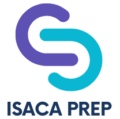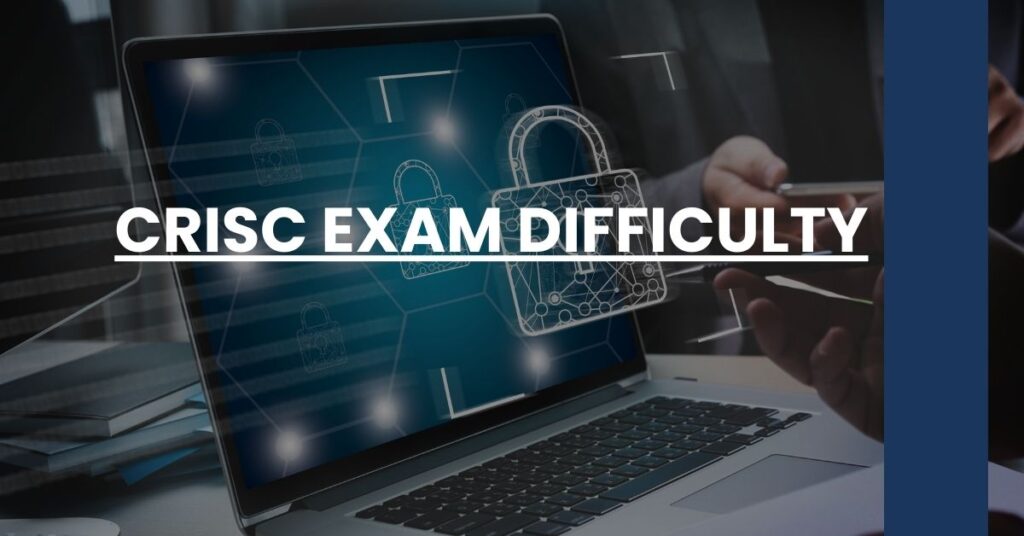Is the CRISC exam difficult? In short, yes—the CRISC (Certified in Risk and Information Systems Control) exam poses a considerable challenge for most, demanding a deep understanding of IT risk management and a strategic mindset to navigate its four domains.
Here’s what to expect from the CRISC exam:
- A meticulous 150-question test covering areas from risk identification to response and mitigation.
- A rigorous preparation process with a clear focus on detailed study and practical application of concepts.
- Key strategies and resources that can help, including ISACA’s own study materials and community support.
Armed with the right approach and dedication, you can tackle the CRISC exam successfully. Keep reading to gain insights on how to prepare and emerge triumphant.
What Is the CRISC Certification?
When you’re eyeing a significant leap in your information systems and enterprise risk management career, obtaining the Certified in Risk and Information Systems Control (CRISC) certification is a move worth considering. This esteemed certification, produced by the Information Systems Audit and Control Association (ISACA), endorses your capability to identify, evaluate, and manage information system risks—a skill that’s in high demand.
Offering more than just a feather in your cap, CRISC is your golden ticket to better job prospects, higher earning potential, and the recognition you deserve as a leader in your field. Since its inception in 2010, over 23,000 professionals have attained CRISC, making it a global standard of achievement in the industry. Embarking on this journey, however, is not without its challenges. The exam’s depth and scope may test your limits, but with commitment and the right preparation, you can emerge victorious and join the ranks of highly regarded CRISC-certified professionals.
CRISC Exam Structure and Content
As you prepare for the CRISC exam, you must first understand its structure. Let’s pull apart the pieces: the exam is built on 150 questions that span across four knowledge-rich domains within a 4-hour time limit. Questions range from analyzing risk to implementing information system control. The domains, as outlined by ISACA, include:
- Domain 1: IT Risk Identification (27%)
- Domain 2: IT Risk Assessment (28%)
- Domain 3: Risk Response and Mitigation (23%)
- Domain 4: Risk and Control Monitoring and Reporting (22%)
Each domain commands attention and encompasses a multifaceted perspective on risk management. The type of questions can have you toggling between your textbook knowledge and real-world scenarios, requiring you to apply what you’ve learned in a practical context. So, while the thought of four hours might seem generous, the intricate nature of the CRISC domains means you’ll need to manage your time prudently.
Exam Difficulty Level Analysis
When you’re sizing up the CRISC exam difficulty, consider the myriad factors that contribute to its reputation as one of the more challenging certifications out there. First off, there’s the sheer volume and depth of knowledge you need to cover. The domains aren’t just broad categories; they drill down into the minutiae of risk management and control, expecting you to know each area inside out.
Next, you have the complexity of the questions themselves. It’s not enough to rote memorize—you’ll be expected to analyze and synthesize information to make sound decisions in hypothetical situations.
Finally, let’s talk numbers—the pass rate. Historically, ISACA has upheld a high standard, with the minimum passing score set at 450. Now, this score doesn’t tell you the percentage of correct answers needed since ISACA uses a scaled score system. But the takeaway here is clear: the CRISC certification demands rigorous preparation.
Preparing for the CRISC Exam
The road to conquering the CRISC exam begins with a solid study plan—and the right materials. From ISACA’s own CRISC Review Manual to an array of online courses and communities like the Certification Station on Discord, there is no shortage of resources at your disposal.
Here’s how you can streamline your prep for this mammoth task:
- Read and Reread: The CRISC Review Manual is not just for perusing. Inhabit it. Mark it up, take notes, and then go over it again.
- Practice Makes Perfect: The CRISC question databases provide a glimpse into the exam environment with practice questions that mirror the actual test’s difficulty.
- Join a Study Group: Dive into online forums or joining study groups. A discourse with fellow risk management aficionados can shed light on complex topics and provide new perspectives.
- Mock Exams: Treat practice tests like the real deal. Time yourself, evaluate your answers critically, and identify areas requiring fortitude.
Skills and Experience Required
Before you embark on the CRISC journey, it’s crucial to gauge if you’re ready. ISACA recommends that you come armed with at least three years of experience in at least two of the CRISC domains, with one of those years being in domain one or two. More than just time spent on the job, you’ll need deep insights into risk management and a well-honed skill set in information system control practices.
Directing your professional development towards these experiences can become your blueprint for success. Each encounter you have with risk assessment or response planning is another layer to your mastery. This isn’t for the faint of heart or the unseasoned; before you sit for this exam, ensure your professional tapestry is rich with applicable, hands-on practice in the beautiful complexity of risk management.
In the following sections, we will dive into typical challenges faced by candidates and how an understanding of the CRISC exam difficulty becomes the groundwork for devising strategies to rise above them.
Typical Challenges and How to Overcome Them
Content: When you set your sights on the CRISC certification, being cognizant of the typical hurdles can mean the difference between stumbling blocks and stepping stones. There’s the issue of depth—this isn’t an exam where surface knowledge will suffice; you’re expected to have a nuanced understanding of every inch of risk management. Then, the time management beast rears its head—150 questions in four hours mean you need to average about 1.6 minutes per question.
But fear not. These mountains can be moved with the right mix of strategy and determination:
- Embrace the Depth: Don’t just learn the concepts; live them. Apply them in your professional environment, debate them with colleagues, and concoct scenarios where you’re the risk management hero.
- Time Management Mastery: Practice full-length, timed exams. This isn’t just about knowing the answers but knowing them swiftly. You’ll be surprised how much quicker you can become with a little stopwatch pressure.
- The Practice Question Tango: Balance reading with doing. If you dive into study materials without testing yourself regularly, you may as well be reading a captivating novel. Dance back and forth between theory and practice to cement your knowledge.
Your strategy should be a personalized cocktail of these methods. No two candidates are the same, and your unique blend will see you through. For some specific pointers on time management and practical scenarios, the Infosec Institute might offer some valuable information.
Comparison with Other ISACA Exams
You might wonder, considering the crisc exam difficulty, how does it stack against other heavy hitters like CISA or CISM? Each ISACA certification exam serves a distinct niche within information systems and control, yet they share a common thread of rigorous standards and the prestige that follows success.
The CISA (Certified Information Systems Auditor) is your IT audit maestro, CISM (Certified Information Security Manager) is the strategic security authority, and CRISC puts you in the driver’s seat of enterprise risk.
Take a CISA-certified professional—they’ve likely tangled with complex audit scenarios. A CISM wizard has strategized over sprawling security frameworks. If you’ve conquered those realms, picturing the challenges of CRISC might be like envisioning a new puzzle when you’ve already mastered similar ones. Conversely, pursuing CRISC first may lay a robust foundation for tackling the others.
Prospective test-takers often find that challenges in these exams intersect—the same deep understanding and strategic thinking are mandatory across the board. Check out personal accounts like those on LinkedIn to get a sense of how these exams compare.
Personal Experiences and Testimonials
Now, for a glimpse of the personal encounters in taming the CRISC exam difficulty beast: each candidate’s journey is as varied as their backgrounds. Imagine the relief as your name is announced as passing. Or the collective wisdom in a study group that helps a member finally unravel a tricky concept.
These shared experiences can be a lifeline—there’s comfort in knowing that you’re not the first to navigate these waters. While personal testaments may vary in detail, common themes emerge: the satisfaction of mastering tough material, the camaraderie among fellow aspirants, and the elation of passing.
But take heed, these tales are not just for motivation; they’re a treasure trove of proven tactics. Sift through discussions on platforms like Certification Station on Discord to unearth study habits and test-taking strategies that others swear by. Just remember, while advice is aplenty, your final battle plan must align with your personal strengths and schedule.
Strategies for Success
As we pencil in the final strokes of your CRISC exam strategy, let’s reiterate: knowing the crisc exam difficulty helps shape a battle plan that’s robust, yet fluid enough to accommodate the twists and turns of this demanding certification process.
To begin with:
- Adopt a Study Schedule: Allocate time slots in your routine that are non-negotiable study hours. Stick to them with an almost sacred fervor.
- Mix and Match Study Methods: Use a variety of resources—manuals, courses, flashcards, online quizzes. This not only keeps the content fresh but caters to different learning styles.
- Simulate the Exam Experience: Recreate the test environment at home. No distractions, just you and a ticking clock. This drill will serve you well on D-day.
- Network with Peers: Leverage the collective intellect of study groups, both online and local. Insight from fellow candidates can shine a light on blind spots.
Remember, strategies are not set in stone. They should evolve as you dive deeper into your preparation process. Flexibility is your friend. Adjust tactics as you glean more about your strengths and areas needing reinforcement. For an extra leg up, consider browsing the Infosec Institute for additional guidance.
Conclusion
With the end in sight, breathe easy knowing that conquering the crisc exam difficulty is within reach. Yes, the road is long, and at times it’s steep. However, with each step—each hour of study, each practice question tackled—you’re equipping yourself with the knowledge and strategic nous that ISACA rewards.
Take pride in the challenge. After all, if it were easy, everyone would do it. But you’re not everyone—you’re setting your sights on being a certified master of risk and control. And with every resource, forum, and expert tip you utilize, remember: they’re all tools in your CRISC odyssey, steering you toward not just a certification, but a sharper, more accomplished version of your professional self. Now march on, future risk champion, with wisdom, courage, and your sights on success.

